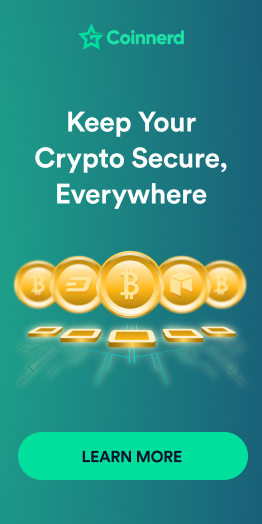Unlocking the Secrets: 100+ Vital Blockchain and Crypto Terms You Must Master

Crypto holds diverse information and a plethora of new terms. CoinNerd Insights curates a list of pivotal blockchain terms to aid your understanding and research of crypto projects.
To search for a term quickly, use Ctrl + F for precise keyword searches. Your feedback is valuable! If you notice missing words, please comment to help CoinNerd Insights update the list comprehensively.
Altcoin
“Altcoin” denotes cryptocurrencies besides Bitcoin. Initially, many were improved versions of Bitcoin. Today’s Altcoins often serve as Utility Tokens, holding value within a project’s ecosystem.
As an illustration, the LINK token compensates Node Operators, while BNB covers transaction fees on Binance.
In Altcoin discussions, “Altcoin season” signifies a period when these coins surge significantly, sometimes doubling, tripling, or even growing tenfold within weeks. How can you identify this season to seize the opportunity?
AMA – Ask Me Anything
AMA stands for Ask Me Anything, an online event where the community asks questions, often in a Livestream or live Q&A on platforms like Facebook, Telegram, where they’re answered.
AMA is a prominent feature in CoinNerd Wallet, hosting weekly sessions with projects to address community inquiries. Additionally, selected insightful questions receive Airdrop rewards chosen by the project.
Airdrop
An Airdrop distributes complimentary tokens to users, often through methods like retroactive allocation, holding or staking the primary token, or fulfilling project-assigned tasks.
Airdrops serve as promotional tactics in advertising and introducing ICO projects, drawing users to participate in the coin project community. Wondering how to select an airdrop project and optimize your chances of earning rewards? Check out the article below for guidance.
ASIC
ASIC (Application-Specific Integrated Circuit) refers to a dedicated integrated circuit designed for a precise function. For instance, an ASIC Bitcoin miner maximizes mining efficiency by channeling all resources toward Bitcoin mining.

ATH – All-Time High
ATH (All-Time High) marks the pinnacle point, whether in price or market capitalization, that a coin, stock, or asset has reached in its trading history.
As an illustration, Bitcoin’s All-Time High stands at $64,000.
Aggregator
An aggregator consolidates various functions within a platform. For instance, it allows users to both swap and lend assets.
Algorithmic Stablecoin – Algorithm-Based Stablecoin
Algorithmic Stablecoins utilize an innovative model to maintain a $1 price via algorithmic mechanisms, independent of asset-backed support.
UST is an instance of an Algorithmic Stablecoin, where the supply and demand of LUNA fluctuate to uphold the stable price of UST.
Asynchronous
JavaScript is a programming language employed in blockchain. Asynchronous execution in JavaScript involves simultaneous processing of statements, enhancing program runtime and resource efficiency. However, this method, while optimizing performance, can make project control and debugging challenging due to unordered statement results.
BAGHOLDER
BAGHOLDERS are individuals holding substantial coin quantities, anticipating future price increases for selling.
Bottom Fishing
Bottom Fishing refers to investors purchasing assets at low prices, believing it’s the lowest point and expecting a subsequent price increase for substantial profits.
Blockchain
A decentralized database, blockchain securely stores data in interconnected, encrypted blocks that grow sequentially.
In straightforward terms, Blockchain functions as a distributed electronic ledger across multiple computers, housing transaction details securely and immutably. The information on this ledger is validated by a network of connected computers, ensuring no alteration, overwriting, or deletion is possible.
Discover the architecture and operational mechanisms of Blockchain, along with insights into its security measures. Explore more: Structure and Operation.

Bull Market (Bullish Trend) – Bull Market
A bull market, or bullish trend, indicates a market experiencing significant growth, marked by coin/token prices surging notably above the historical average, sustained over an extended period with substantial volumes.
During a Bull Market, the demand for buying exceeds the selling pressure.
Bear Market (Bearish Trend) – Bear Market
Unlike a Bull market, a Bear market (or Bearish) refers to a downtrending market where coin/token prices experience a prolonged and abrupt decline.
During a Bear Market, the selling demand surpasses the buying pressure.
Binary Option
Binary Option refers to a game involving users predicting short-term candle prices; winning predictions result in monetary gains, while incorrect predictions lead to losses.
Breakout
Breakout, in Technical Analysis, defines the event when a price breaches either a support or resistance level.
Tools like moving averages, trend lines, price patterns (like head and shoulders, candlesticks, etc.), indicators, and various technical figures aid in identifying price breakouts.
Bridge – Blockchain Connection
In simple terms, a Bridge acts as a connection between blockchains. This facilitates the transfer of assets, which, due to varying standards across blockchains, would otherwise not be easily tradable.
Hence, a Cross-chain bridge facilitates the transfer of crypto assets, tokens, or data between different blockchains, spanning layer 1, layer 2, sidechain, and childchain networks.
Cross-chain bridges have gained popularity, offering various types and investment opportunities across numerous projects. Explore the potential and emerging trends of Cross-chain bridges in the article below for deeper insights.

Circulating Supply
Circulating Supply represents the overall quantity of coins in circulation within the market.
CEX – Centralized Exchange
CEX refers to Centralized Exchange, a platform managed by a third party (an owning company or organization). Your deposited electronic assets within the exchange are controlled and managed by this entity. Popular examples include Binance, Okex, Huobi, among others.
CEX offers rapid transaction processing and ample liquidity, but it also exercises complete control over your assets. Thus, the paramount consideration in selecting a CEX platform is its reputation.
Child Node
A child node, within the Blockchain, is an expanded form derived from another node known as the parent node.
Collateral Asset
A collateral asset signifies the security or guarantee put forth by a user. It involves depositing assets into projects to secure a loan. Repaying the loan typically incurs a fee (varies per project) to retrieve the collateral. These assets are commonly associated with lending projects like MakerDAO, Venus, Unit Protocol, and others.
Cross-Chain
Cross-chain is a solution facilitating asset transfers across different chains, enhancing the integration of various chains, and commonly applied to projects operating on multiple blockchains.
For instance, users can access Sushiswap’s services across Polygon, Ethereum, and more.
Cliff
This term frequently appears in project token release schedules. A “cliff” denotes a token lock period during which individuals in this category do not receive any tokens. It commonly pertains to tokens held by teams, advisors, or investors.
For instance: Team Allocation: Cliff 12 months, vesting 12 months. This implies that no tokens are allocated to the team for the initial 12 months. From month 13 to month 24, tokens are distributed in 1/24 installments.
CeDeFi
The amalgamation of Decentralized Finance and Centralized Finance applications serves as a connector between CeFi and DeFi. CeDeFi enables easier access to Crypto and DeFi markets for individuals and organizations, ensuring compliance with legal regulations.
Dapp – Decentralized Application
Dapp (Decentralized Applications) are applications built on existing platforms and protocols in a decentralized manner. They aim to address specific issues in a particular field, often employing tokens within the application.
As Dapps are constructed directly on platforms, their characteristics are contingent on these platforms. Factors like transaction speed, TPS, scalability, and stability are examples of these platform-dependent traits.
Derivatives
Derivatives represent financial instruments enabling investors to trade various products based on price without owning the underlying asset. Employing derivatives grants investors the ability to purchase larger amounts (leveraging) of assets they possess.
For instance: Trading derivatives in oil, Bitcoin, weather, and more.

DeFi – Decentralized Finance
DeFi, short for Decentralized Finance, represents decentralized financial applications built on blockchain platforms. Users can freely utilize these applications without relying on a trusted intermediary, like a bank, as they maintain control over their assets.
Traditional finance’s significant limitation lies in its centralization or concentration of power. DeFi emerged as a solution to tackle this issue. How exactly does it address the problem ingrained in traditional finance? Delve into the article below to gain deeper insights into the nature and potential of DeFi.
Swing The Top
In Vietnamese trading terms, “swinging top” refers to inadvertently purchasing a coin or token at its peak price, followed by a subsequent drop in price, leaving insufficient time to sell, resulting in a prolonged mistake.
DYOR – Do Your Own Research
DYOR stands for “Do Your Own Research,” signifying the advice for readers to independently investigate and comprehend a specific subject matter. Typically featured at the start or conclusion of an article, this term serves as a disclaimer from the author, encouraging users to conduct their own research before making decisions based on the article’s information.
DYOR, often featured in articles, aims to prompt readers to meticulously delve into the subject matter and avoid relying solely on the writer’s perspective. This practice holds particular significance in the Crypto sphere, where individuals might write favorably about projects they’ve invested in, potentially influencing others to buy tokens.
These projects have both positive and negative aspects. The distinction lies in whether the project team genuinely aims to develop a product and commit to the long-term prospects of Crypto, or if their intentions are geared solely towards short-term gains. How does conducting thorough research (DYOR) lead to favorable investment outcomes?
DEX – Decentralized Exchange
DEX (Decentralized Exchange) is an exchange operating in a decentralized manner. In DEXs, cryptocurrency trades occur directly between buyers and sellers without intermediaries or central authority overseeing the process. Examples include Uniswap, Sushiswap, PancakeSwap. The contrary counterpart to DEX is CEX.
DAO – Decentralized Autonomous Organization
DAO stands for Decentralized Autonomous Organization—an entity run by its members following a predefined set of rules implemented in code, often in the form of consensus or smart contracts.
Every member holds the privilege to vote on pivotal decisions within DAOs. As participants, they’re entitled to receive rewards for contributing to the functioning of the DAOs.
It’s essentially various groups collaborating based on a set of rules to achieve a shared objective, and each participant in the process is entitled to rewards.

On-Chain Data
On-chain data refers to asset information stored on the blockchain, encompassing details like token-holding wallet counts, transaction volumes, exchange deposit/withdrawal statuses, and more. Analyzing this data aids in predicting asset conditions, including price fluctuations, supply-demand dynamics, and future trends.
Ecosystem – Blockchain’s ecosystem
The blockchain ecosystem encompasses various interconnected products within the crypto realm. Each blockchain serves as an infrastructure provider, striving to develop a comprehensive and self-sustaining ecosystem that supports and interlinks multiple functionalities.
Defining the exact number of projects within an ecosystem might vary, but identifying an ecosystem isn’t typically a challenging task.
Presently, popular ecosystems include Ethereum, Binance Smart Chain, Solana, Terra, and Near among others.
Ethereum 2.0
Ethereum 2.0 is an Ethereum upgrade transitioning from POW (Proof-of-Work) to POS (Proof-of-Stake), enhancing transaction speed and scalability.
Etherscan
Etherscan serves as a tool to explore, track, and search transactions within the Ethereum Blockchain network. It provides comprehensive data on tokens, ERC-20 addresses, and transaction history on Ethereum.
ERC-20
ERC-20 (Ethereum Request For Comment) is a prominent technology within the Ethereum Network, widely adopted for Smart Contract implementation when creating Tokens on the Ethereum Blockchain.
Apart from ERC-20, Ethereum hosts other token standards like ERC-721, ERC-223, among others.
EMA
EMA, or Exponential Moving Average, serves as a key technical analysis tool, often observed for candlestick support and resistance levels.
Fiat
Fiat money, also referred to as government-issued currency, holds no intrinsic worth and derives its value from a nation’s economic stability and utility.
The USD, issued by the US Federal Reserve (FED) and backed by the US Federal Government, stands as one of the most prominent and influential fiat currencies worldwide.
Fibonacci
Fibonacci, derived from Leonardo Fibonacci’s mathematical theory, serves as a key technical analysis tool. Traders utilize Fibonacci to chart support and resistance lines, identify entry and exit points, and set Take Profit and Stop Loss positions.
FOMO – Fear Of Missing Out
FOMO, or Fear of Missing Out, represents the anxiety or apprehension about missing out on potential opportunities. It’s a widely observed psychological aspect among investors across various trading platforms, from stocks and Forex to cryptocurrencies.
Full Lock Duration
Including a potential Cliff phase, if applicable. In many instances, without a Cliff, the entire lock duration equals the vesting period.
For instance, team or seed tokens often don’t commence vesting right after the Token Generation Event (TGE). Instead, they might have a period of no distribution, typically termed as a “cliff.” If there’s a 12-month cliff, and a linear 24-month vesting schedule, it implies no coin allocation for the first 12 months. Then, from month 13 to month 36, a fraction (1/24) of the coins is allocated each month.
Full Node
Full nodes possess the capacity to download an entire copy of a specific Blockchain network and validate new transactions based on the consensus principle.
Flash Loan
A Flash Loan is an uncollateralized form of loan that necessitates returning the loan amount to the lending platform within the same transaction. It involves borrowing funds, performing activities with that loan, and then repaying the borrowed amount, all within a single transaction.
FUD – Fear, Uncertainty & Doubt
FUD represents Fear, Uncertainty & Doubt, reflecting anxiety, skepticism, and uncertainty among investors due to negative market news, often leading to selling off assets.
FOMO and FUD significantly impact cryptocurrency traders’ decision-making, potentially leading to asset loss and undermining trust in their choices. How can traders steer clear of FOMO & FUD psychology to make more informed decisions?
FDV
FDV, or Fully Diluted Cap, is computed by multiplying the maximum total token supply of a project with the current value of one token. Platforms like CoinGecko and CoinMarketCap typically display FDV for each token.
Gas Fee
When a user executes a transaction on the blockchain, like buying, selling, or approving, a fee is necessary to add the transaction to a block. This fee is known as Gas Fee and is calculated in Gwei. Higher Gwei values result in higher gas fees, but ensure faster transaction processing.
Gas fee calculation formula: Gas Fee = Gas Limit * Gas Price
Gas War
A gas war occurs when multiple users intentionally raise the Gwei, paying more to expedite transactions. This impacts the blockchain network as others must pay higher fees for their transactions. Gas war tactics are often executed by automated bots.
Gem
A “gem” or “hidden gem” denotes projects with promising potential but low token/coin prices. These are typically Low Cap or Mid Cap projects expected to experience substantial growth, potentially reaching x5, x10, or even x100 in value.
Hackathon – Software Development Competition
Hackathons are developer competitions aimed at fostering potential projects within a specific ecosystem. Projects are evaluated by a panel of judges, and prizes are awarded to the most promising entries.
Examples of hackathons include events like the DeFi Connected Hackathon by Terra and the Solana Season Hackathon organized by Solana.
Halving
Halving is a critical event in Bitcoin’s cycle that occurs approximately every four years, reducing block rewards by half. This process, known as Bitcoin Halving, is significant for its impact on the cryptocurrency’s supply dynamics.
This feature mimics the gold mining process, gradually heightening scarcity and mining difficulty. Halving events aren’t exclusive to Bitcoin; Litecoin and several other cryptocurrencies follow similar halving patterns.
Hard Cap – Maximum Mobilized Capital
The Hard Cap represents the maximum fundraising goal a project aims to achieve through ICOs or IEOs.
Hard Fork
A hard fork is a significant update to a blockchain protocol that creates a divergence from the previous version, resulting in the splitting of the blockchain into two separate systems.
Bitcoin Cash originated from a hard fork of Bitcoin aiming to expand block size to 8MB, providing a solution for scalability issues in the original Bitcoin network.
Hodl/Hold Coin
“Hodl” is a crypto term for holding onto cryptocurrencies for the long term, anticipating price increases. It’s a strategy where investors buy and retain coins, waiting for potential value appreciation. Common phrases include “Hold to die,” “Hodl or let go,” or “Which one to hold?”
The person holding onto assets is often referred to as a “Holder.” Conversely, someone actively trading assets is called a “Trader.”
HYIP – High Yield Investment Programs
HYIP stands for “High Yield Investment Programs,” promising high returns. However, most high-profit investment schemes turn out to be scams, posing significant risks.
Why do investors still flock to HYIP projects? Despite risks, some navigate wisely, using careful selection and rational investment strategies to mitigate losses.
ICO – Initial Coin Offering
ICO (Initial Coin Offering) is akin to a company’s IPO (Initial Public Offering), initiating the first release of coins to gather capital in the Crypto market.
IDO
An IDO, or Initial Decentralized Exchange Offering, is a means of fundraising hosted on decentralized platforms like Polkastarter, Poolz, Dao Maker, diverging from centralized exchanges such as Binance.
IEO
An IEO, or Initial Exchange Offering, functions akin to an ICO for capital raising but involves crowdfunding via token offerings conducted on exchanges.
You might recognize Binance Launchpad, a platform listing projects offered through IEOs. Some recent examples include Injective Protocol (INJ) and Sandbox (SAND).
IFO
An IFO, or Initial Farm Offering, is akin to IDO and ICO in terms of capital raising. However, IFOs utilize LP tokens (received from liquidity provision) as entry tickets for participation.
IPO
IPO, or Initial Public Offering, signifies the initial offering of shares to the public by a company seeking to raise capital, allowing it to be publicly traded on the stock exchange.
Impermanent loss (IL)
Impermanent loss refers to the fluctuating value difference between providing liquidity and holding assets in a wallet, leading to potential loss. This term gained prominence during the rise of Yield Farming in August 2020.
KYC – Know Your Customer
KYC (Know Your Customer) is a regulatory measure requiring Crypto market entities to verify their customers’ identities. This aims to prevent illicit activities and money laundering within the virtual currency market, meeting government compliance standards.

Layer
Layer refers to the hierarchical structure of blockchains. Layer 1 represents the primary blockchain, while Layer 2 addresses the limitations of Layer 1. This concept is particularly relevant in Ethereum due to challenges like high fees, congestion, and scalability issues.
Leaf Node
This refers to a specific node within blockchains. A leaf node is a node that lacks any child nodes.
Launchpad
The Launchpad serves as a platform for ongoing projects to release tokens and secure IDO funding. Some prominent names in this realm are Polkastarter, DAO Maker, Solstarter, BSCPad, among others.
Leverage
Leverage, in simple terms, allows users to borrow funds from the exchange to amplify potential gains when the market moves favorably (going long when prices rise or shorting when prices drop). However, it also heightens losses if the market moves in the opposite direction (long positions in a declining market or short positions in a rising market).
Liquidity
Liquidity refers to the abundance of available assets for trading on exchanges like DEX or CEX. Higher liquidity implies minimal price fluctuations during transactions, reflecting a strong market demand for trading.
Assets like BTC and ETH exhibit high liquidity. Transactions involving around $10,000 in these assets generally don’t cause significant market price swings. However, using the same amount to purchase newly launched tokens could significantly spike their prices due to limited availability in the market.
Liquidity Provider
These individuals supply liquidity to DEX platforms like Uniswap or Sushiswap. In return, they earn a share of transaction fees and potentially other rewards, such as project tokens. However, if not managed meticulously, this could result in impermanent loss.
Long – Buy With Leverage
Going long involves borrowing funds from an exchange using leverage to purchase an asset, anticipating a price increase to sell it later, and then repaying the borrowed capital along with borrowing fees to the exchange.
For instance, suppose a trader has $100 and applies x10 leverage, allowing them to borrow $900 from the platform, combining it with their $100 to create a $1,000 position. If the asset’s value rises, the trader can close the long position, sell the asset, and repay the $900 plus fees to the platform, keeping the profit and the initial capital. Yet, a significant drop in the asset’s value could lead to liquidation, resulting in a loss of the $100 capital. This method involves high risk and the potential for high returns.
Mainnet – Official Network
The mainnet represents the official version of a blockchain network that developers implement after successfully testing it on the testnet.
The release of the mainnet signifies the establishment of a cryptocurrency’s independent blockchain network, complete with its own wallet platform. However, the mainnet is subject to potential changes as new updates are introduced by the project team.
Margin -Margin Trading
Margin trading involves borrowing assets from an exchange to amplify trading capital. Once profits are gained or if liquidation occurs, the borrowed assets are returned to the exchange. Margin trading encompasses both long (buy) and short (sell) positions.
Mint
“Mint” refers to the process of generating or creating tokens, often observed in projects that involve using collateral to borrow the desired token.
Money Flow
Money flow denotes the overall cash movement within the market. As money enters an ecosystem, it tends to drive up the prices of tokens within that system—a concept akin to a rising tide lifting all boats.
Multichain
Multichain refers to projects designed to integrate with various blockchains, allowing assets from different chains to utilize the project’s services without necessitating conversion to a specific blockchain.
Market Cap
Market cap represents the total value of a cryptocurrency, computed by multiplying the coin’s price by the total number of coins in circulation.
MasterNodes
These servers execute various tasks within the system. Masternodes essentially function as Blockchain wallets that operate online with a fixed, static IP address.
Minning, Minner
Mining involves the process of extracting coins, and miners are the individuals engaged in this coin extraction activity.
MMO – Make Money Online
MMO, short for “Make Money Online,” involves using a computer or internet-connected device, typically a computer, to perform various tasks or work with the aim of generating income.
NFT
NFT stands for Non-Fungible Token, implying that each token is unique and cannot be substituted. Unlike fungible tokens, like a $5 bill that can be exchanged for another $5 bill, NFTs represent distinct assets with individual properties, making them irreplaceable. For instance, a house owned by person A cannot be traded for a house owned by person B due to their unique characteristics, showcasing the concept of non-fungibility.
NFTs are predominantly utilized in art and gaming, typically employing various formats like ERC721 and ERC1155.
Non-custodial
Non-custodial typically applies to DEX exchanges and wallets that don’t retain user funds. In these setups, the manufacturer develops the product, while users retain ownership of their assets. Unlike centralized exchanges (CEX), users on DEX don’t need to create accounts or deposit funds, ensuring they maintain control of their assets.
Another distinguishing factor between Non-custodial and Custodial services is whether the user possesses the passphrase or private key of the wallet. In Non-custodial setups, users have control over these keys, ensuring their ownership and security.
Nonce
Blockchain comprises three fundamental components: Blocks, Nodes, and Miners. Each block within the blockchain contains essential elements: Data, Nonce, and Hash through a hashing function. A nonce, a 32-bit (4-byte) integer, is a crucial part of this hashing function within the blockchain. Miners aim to discover this number to receive rewards. For instance, mining on the Ethereum blockchain could yield miners 5 ETH as a reward.
The challenge of finding an appropriate nonce to add to the hash in a blockchain remains consistent. If miners fail to discover a suitable nonce within a specified time frame, the project will adjust the difficulty level of that block. The nonce holds a crucial role in the mining process of cryptocurrencies.
OTC
OTC, short for Over the Counter, denotes decentralized markets where transactions occur outside conventional exchanges. It involves buying and selling assets directly, often through individual brokers or authorized OTC trading entities.
For instance, platforms such as Huobi’s C2C and Binance OTC facilitate direct transactions for buying and selling assets like BTC, USDT, or stocks using local currency directly via banking channels. Individual OTC brokers also offer similar services.
Oracle
An Oracle is a vital component in DeFi, as it assists crypto projects in updating real-world data. Projects dedicated to Oracle services, such as Chainlink, Band Protocol, and DIA, play a crucial role in this space.
Order-book
This system works like an order book where users create orders to buy or sell, which are then listed and await other users to match those orders. Exchanges like Binance, Okex, Huobi, and Kucoin, typically known as CEX, employ this order book mechanism.
Parent Node
The node comprises expanded nodes referred to as child nodes.
Pump & Dump
Pump and Dump is a term describing a type of market manipulation tactic.
- Pump refers to artificially inflating the market price.
- Dumping involves selling large quantities of assets on the market, causing the price to plummet.
Pump and dump schemes are prevalent across various markets including stocks, forex, cryptocurrencies, and even commodities like gold.
Pump (raising the price) and dum (lowering the price) are fundamentally illegal actions. Despite this, the crypto market lacks a robust legal framework, leading to these occurrences being fairly common.
Pool
Frequently observed in DEX and lending projects, a pool denotes a reservoir where users deposit assets, waiting for others to engage in buying, selling, and borrowing activities as needed. The individual who deposits assets into the pool is termed the Liquidity Provider and earns transaction fees in return.
PoA – Proof of Authority
PoA, or Proof of Authority, stands for proof of authorization, presenting a consensus algorithm rooted in reputation. It provides a practical and efficient solution for blockchain networks.
PoB – Proof of Burn
PoB, or Proof of Burn, is an alternative consensus algorithm aimed at addressing the energy consumption issue associated with POW. Instead of employing miners, participants are required to burn or destroy tokens. This action grants them the ability to write blocks in proportion to the coins burned.
PoD – Developer Proof
PoD, or Proof of Developer, is a mechanism developed in 2014 for cryptocurrency projects and ICOs to validate their active management by the developer(s). In the realm of crypto, PoD is sometimes mistaken for Proof of Delivery in financial contexts.
PoS – Proof of Stake
PoS, or Proof of Stake, is a mining method reliant on the number of coins possessed. Miners gain rewards in proportion to their coin holdings; owning 5% of the coins allows mining 5% of the available coins.
PoW – Proof of Work
PoW, or Proof of Work, is a mining method that hinges on computer processing power. The more robust a machine is, the more efficient it becomes in mining operations.
Ponzi
Ponzi schemes operate as multi-level pyramid fraud models that promise high returns to investors. Essentially, they use new investors’ money to pay returns to earlier investors. When it becomes unsustainable, the scheme collapses, leaving investors unable to retrieve their capital.
Some well-known examples of Ponzi schemes include Bitconnect, Ifan, and Pincoin.
QR Code
A QR Code, or Quick Response code, is a type of barcode that efficiently encodes information, typically used for various purposes, including storing website links, due to its square shape.
Replay Attack
A replay attack is a malicious assault on a network where data is either blocked or transmitted slowly, disrupting the system by repeatedly sending the same information.
Root Node
The topmost node within the Blockchain network.
Rekt
“Rekt” is a term used to describe a significant failure or a person’s downfall, particularly in coin trading, indicating substantial losses akin to being “toang”.
Return On Investment
ROI, or Return On Investment, measures the profitability of an investment, representing the percentage of profit gained in relation to the total investment amount.
SHA
SHA, which stands for Secure Hash Algorithm, comprises five algorithms recognized by FIPS (Federal Information Processing Standard). It serves as a method for data transfer, essentially encoding data from point A to point B, but reversing this translation from point B back to point A is not feasible.
- SHA-1 (trả lại kết quả dài 160 bit).
- SHA-224 (trả lại kết quả dài 224 bit).
- SHA-256 (trả lại kết quả dài 256 bit).
- SHA-384 (trả lại kết quả dài 384 bit).
- SHA-512 (trả lại kết quả dài 512 bit).
Sibling Node
The node is linked to the larger node, known as the parent node.
Satoshi
Satoshi Nakamoto is credited with being the mind behind Bitcoin. Additionally, a sat or Satoshi represents the smallest unit of Bitcoin: 1 BTC = 100,000,000 sat.
Shill – Pumping up the news
Shilling was the former currency of England and Austria. However, in the context of cryptocurrency, “shilling” is used to describe the act of artificially promoting or hyping up a project to drive up the value of a particular coin.
Smart Contract
A smart contract refers to computer-coded protocols that independently establish, verify, and execute agreements using the capabilities of Blockchain technology.
The entirety of the Smart Contract process occurs autonomously and without external interference.
Soft Fork
Soft forks are software alterations that remain compatible with the previous interface. Typically, they don’t demand users to update to the most recent version of the current interface.
Yet, upgrading enhances your software’s capability to surpass the limitations of the old version and ensures better compatibility with new applications.
Stablecoin
Stablecoins are cryptocurrencies pegged to a stable asset, aiming to bring stability to the volatile cryptocurrency market.
Stablecoins require collateralization with assets they are tethered to, such as gold (like Digix Gold Tokens – DGX), specific fiat currencies (such as Tether – USDT), or even other cryptocurrencies (like MakerDAO – DAI).
Short – Sell With Leverage
Unlike going long, shorting involves borrowing assets from the platform using a specific leverage and promptly selling them. Subsequently, the short position waits for a decrease in price to repurchase the assets at a lower rate and return them to the platform, accounting for borrowing fees.
For instance, let’s say a player starts with $100 and utilizes a x10 leverage, enabling them to borrow $900 worth of assets from the platform. They sell these assets for $1,000. When the asset price falls, they close the short order, repurchase the assets at a lower price, and return them to the platform along with fees. The profit and capital remain with the player. However, if the asset price surges, they face the risk of liquidation, losing the initial $100 capital. This type of trading is high-risk but can yield high returns.
Testnet
A testnet is a trial blockchain version specifically designed for developers to experiment with new functionalities and updates without impacting the existing protocol.
Typically, each coin operates its own testnet to facilitate the testing of new features and developments.
Trader
Traders encompass various investors, but the term is often associated with short-term investors who engage in buying and selling over days, weeks, or months, and may utilize margin trading tools.
The opposite of Trader is Holder.
TVL – Total Value Locked
The concept of Total Value Locked (TVL) emerged during the DeFi surge. TVL represents the total value of assets users have invested in DeFi projects, predominantly in DEX and Lending through liquidity provision. Websites like defillama.com or defipulse.com offer real-time tracking of the current TVL.
TPS
TPS, or Transaction per Second, denotes the quantity of transactions a network can process within a second. Its computation involves the formula:
TPS = (Max Block Size / Average Transaction Size) / Target Block Time.
For instance, suppose a blockchain possesses a 1MB block size, an average transaction size of 1KB, and a 30-second block time. Calculating the theoretical TPS:
TPS = (1MB/1KB)/30 seconds = 33.
A higher TPS signifies more efficient management of congestion within the blockchain network. It brings heightened payment efficiency and increases the likelihood of acceptance by significant agencies and organizations. However, achieving a high TPS doesn’t guarantee success at the highest level or ensure competitiveness with established networks like Ethereum and Bitcoin. Factors like performance and security also profoundly impact overall success in this domain.
Vesting
This term often appears in project token release schedules. Vesting refers to a timeframe during which tokens are distributed gradually. Individuals within this arrangement receive tokens progressively until they eventually obtain the complete allocation. Typically, this pertains to tokens held by teams, advisors, or investors.
For instance: Team Allocation: 12-month cliff, 12-month vesting implies that no tokens are allocated to the team during the initial 12 months, with tokens gradually released from month 13 to month 24.
Vesting Period
The token distribution occurs gradually following the vesting schedule.
For instance: Linear monthly vesting over 12 months implies receiving 1/12th of the total tokens every month for a year.
Volatility
Volatility is the measure of market fluctuations. It’s a metric that gauges the degree of price variation in financial assets such as stocks, cryptocurrencies, gold…
The higher the volatility index, the more susceptible the asset’s value is to sudden fluctuations (rise/fall) within a short period.
Cold Wallet
A cold wallet securely stores private keys offline, completely disconnected from the Internet, minimizing hacking risks. There might be sporadic internet connections for transactions, but the keys primarily remain offline, ensuring a higher level of security.
Volume
Volume, or trading volume, gauges the total monetary value traded within a specified time frame. It’s calculated based on the aggregate amount of coins/tokens bought and sold during that duration.
Whitelist
The whitelist is an essential term for ICO investments. Essentially, it’s a list of approved participants allowed to purchase tokens during the fundraising phase of a project. Typically, completing KYC is necessary to be included in this list.
Yield Farming
Yield Farming, a subset of DeFi, involves users earning returns by lending or borrowing their assets within DeFi protocols.
YTD
YTD (Year to date) is a measure that tracks performance from the beginning of the present calendar or fiscal year up to the current date.
Permissionless Blockchain
A permissionless blockchain, also known as a public blockchain, allows anyone to engage in the consensus process, validating transactions and adding data to the blockchain. Participants operate independently, without requiring trust among each other for the system to function.
Crypto Asset Management
Crypto asset management involves the acquisition, sale, and oversight of digital assets aimed at investment and enhancing their overall value. While asset management isn’t a novel concept, managing a portfolio that includes crypto assets, or even exclusively comprises them, has become essential due to the higher volatility of cryptocurrencies compared to traditional financial assets.
Summary
Here are some common terms often encountered in the crypto sphere related to blockchain. If there are any terms I’ve missed, feel free to drop a comment below, and I’ll promptly include them!
READ MORE NEWS ON
Bitcoin | Inflation Deflation Deflation Inflation Cryptocurrencies
* We hope this information will help you in your investment process, but this is not investment advice. Every investment carries risk, especially in this industry, so DYOR before making a decision.






